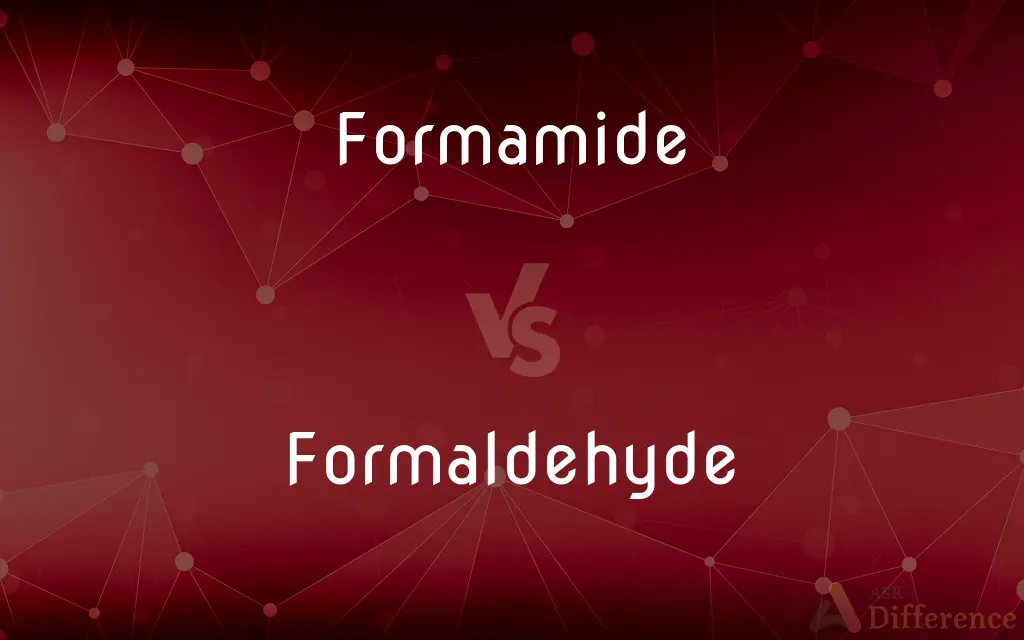Formamide vs. Formaldehyde — What's the Difference?
Edited by Tayyaba Rehman — By Fiza Rafique — Updated on September 30, 2023
Formamide is an organic compound used as a solvent. Formaldehyde is a simple aldehyde used as a disinfectant and in resin production. Both are chemicals but have different structures and uses.

Difference Between Formamide and Formaldehyde
Table of Contents
ADVERTISEMENT
Key Differences
Formamide and formaldehyde, though both belonging to the realm of organic chemistry, have distinctive molecular structures and functions. Formamide, represented chemically as HCONH₂, is a clear liquid often utilized as an industrial solvent. On the other hand, formaldehyde, with the formula CH₂O, is a pungent gas and a well-known preservative and disinfectant.
The applications of formamide and formaldehyde greatly differ. Formamide finds its primary use in the synthesis of various organic compounds, serving as a solvent due to its unique properties. Meanwhile, formaldehyde is commonly known for its use in producing resins, textiles, and as a tissue preservative in laboratories.
The safety profiles of formamide and formaldehyde are also contrasted. While both chemicals require careful handling, formaldehyde is notably more hazardous, known to be a potential carcinogen and an irritant to eyes, nose, and throat. Formamide, though less toxic than formaldehyde, still poses health risks upon prolonged exposure.
In sum, formamide and formaldehyde, despite being organic compounds, differ widely in terms of their chemical makeup, uses, safety profiles, and environmental implications.
Comparison Chart
Chemical Formula
HCONH₂
CH₂O
ADVERTISEMENT
State at Room Temp.
Liquid
Gas
Primary Use
Solvent, synthesis of organic compounds
Disinfectant, resin production, tissue preservation
Toxicity
Moderately toxic
Highly toxic, potential carcinogen
Environmental Impact
Affects water and soil quality
Contributes to smog, affects air quality
Compare with Definitions
Formamide
A derivative of formic acid with ammonia.
Formamide is formed when formic acid reacts with ammonia.
Formaldehyde
A simple aldehyde gas with the formula CH₂O.
Breathing in formaldehyde fumes can be harmful.
Formamide
A clear liquid used in organic synthesis.
Formamide played a crucial role in the compound's production.
Formaldehyde
A known potential carcinogen with a pungent odor.
The room smelled strongly of formaldehyde after the spill.
Formamide
An organic solvent with the formula HCONH₂.
This reaction requires formamide as a solvent.
Formaldehyde
A chemical used in textile production.
Formaldehyde ensures the fabric remains wrinkle-free.
Formamide
A polar solvent in the laboratory setting.
Ensure the formamide is of high purity for this experiment.
Formaldehyde
A common disinfectant and tissue preservative.
The lab specimens are preserved in formaldehyde solution.
Formamide
A compound aiding in various chemical reactions.
Without formamide, the yield of the product was significantly reduced.
Formaldehyde
A key component in producing resins and plastics.
This plastic is derived from a formaldehyde-based resin.
Formamide
Formamide, also known as methanamide, is an amide derived from formic acid. It is a clear liquid which is miscible with water and has an ammonia-like odor.
Formaldehyde
Formaldehyde ( (listen) fer-mal-duh-hahyd, also (listen) for-) (systematic name methanal) is a naturally occurring organic compound with the formula CH2O (H−CHO). The pure compound is a pungent-smelling colorless gas that polymerises spontaneously into paraformaldehyde (refer to section Forms below), hence it is stored as an aqueous solution (formalin).
Formamide
(organic compound) The amide of formic acid HCO-NH2 or any N-substituted derivative; they are used in the synthesis of pharmaceuticals
Formaldehyde
A pungent colorless flammable gaseous compound, CH2O, the simplest and most reactive aldehyde, used for manufacturing melamine and phenolic resins, fertilizers, dyes, and embalming fluids and in aqueous solution as a preservative and disinfectant.
Formaldehyde
(organic compound) The simplest aldehyde, HCHO, a colourless gas that has many industrial applications; it dissolves in water to give formol (10%) and formalin.
Formaldehyde
A colorless, volatile liquid, H2CO, resembling acetic or ethyl aldehyde, and chemically intermediate between methyl alcohol and formic acid.
Formaldehyde
A colorless poisonous gas; made by the oxidation of methanol
Common Curiosities
How is formaldehyde produced?
Formaldehyde is commonly produced by oxidizing methanol.
What is the primary use of formamide?
Formamide is mainly used as a solvent and in the synthesis of organic compounds.
What does formamide smell like?
Formamide has a faint, ammonia-like odor.
Is formaldehyde dangerous?
Yes, formaldehyde is a potential carcinogen and can irritate the eyes, nose, and throat.
How can I reduce formaldehyde exposure at home?
Ventilation, using low-emission products, and keeping indoor plants can help reduce formaldehyde levels.
Why is formaldehyde in cosmetics?
Formaldehyde or its releasers can act as preservatives in cosmetics.
Is formamide used in pharmaceuticals?
Formamide can be used in the synthesis of certain pharmaceuticals.
Is formamide flammable?
Formamide has a low flammability.
Is formamide naturally occurring?
Yes, formamide has been detected in space and is proposed as a precursor to life.
Can formamide be harmful if ingested?
Yes, ingesting formamide can be harmful and may lead to health complications.
Can formamide be used in biological research?
Yes, formamide is sometimes used in molecular biology, especially in DNA denaturation.
What materials release formaldehyde at home?
Particleboard, plywood, and certain insulations can release formaldehyde.
Are formaldehyde fumes visible?
No, formaldehyde is a colorless gas, but it has a strong, pungent odor.
In which industries is formaldehyde prevalent?
Formaldehyde is commonly found in the textile, plastic, and wood industries.
How is formamide disposed of safely?
Formamide should be disposed of as hazardous waste, following local regulations.
Share Your Discovery

Previous Comparison
Inconel vs. Monel
Next Comparison
AD vs. BCAuthor Spotlight
Written by
Fiza RafiqueFiza Rafique is a skilled content writer at AskDifference.com, where she meticulously refines and enhances written pieces. Drawing from her vast editorial expertise, Fiza ensures clarity, accuracy, and precision in every article. Passionate about language, she continually seeks to elevate the quality of content for readers worldwide.
Edited by
Tayyaba RehmanTayyaba Rehman is a distinguished writer, currently serving as a primary contributor to askdifference.com. As a researcher in semantics and etymology, Tayyaba's passion for the complexity of languages and their distinctions has found a perfect home on the platform. Tayyaba delves into the intricacies of language, distinguishing between commonly confused words and phrases, thereby providing clarity for readers worldwide.















































